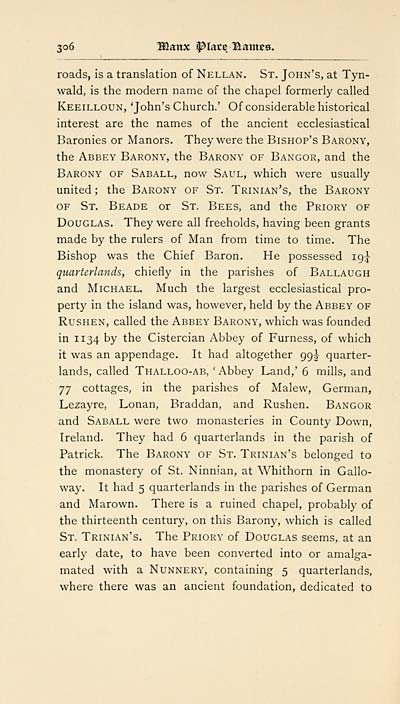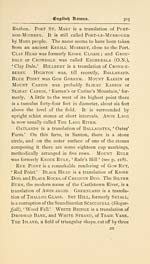Download files
Complete book:
Individual page:
Thumbnail gallery: Grid view | List view

3o6 Manx ^lac^ Bames.
roads, is a translation of Nellan. St. John's, at Tyn-
wald, is the modern name of the chapel formerly called
Keeilloun, 'John's Church.' Of considerable historical
interest are the names of the ancient ecclesiastical
Baronies or Manors. They were the Bishop's Barony,
the Abbey Barony, the Barony of Bangor, and the
Barony of Saball, now Saul, which were usually
united ; the Barony of St. Trinian's, the Barony
of St. Beade or St. Bees, and the Priory of
Douglas. They were all freeholds, having been grants
made by the rulers of Man from time to time. The
Bishop was the Chief Baron. He possessed ig^-
quarterlands, chiefly in the parishes of Ballaugh
and Michael. Much the largest ecclesiastical pro-
perty in the island was, however, held by the Abbey of
RusHEN, called the Abbey Barony, which was founded
in 1 134 by the Cistercian Abbey of Furness, of which
it was an appendage. It had altogether gg^^ quarter-
lands, called Thalloo-ab, ' Abbey Land,' 6 mills, and
yj cottages, in the parishes of Malew, German,
Lezayre, Lonan, Braddan, and Rushen. Bangor
and Saball were two monasteries in County Down,
Ireland. They had 6 quarterlands in the parish of
Patrick. The Barony of St. Trinian's belonged to
the monastery of St. Ninnian, at Whithorn in Gallo-
way. It had 5 quarterlands in the parishes of German
and Marown. There is a ruined chapel, probably of
the thirteenth century, on this Barony, which is called
St. Trinian's. The Priory of Douglas seems, at an
early date, to have been converted into or amalga-
mated with a Nunnery, containing 5 quarterlands,
where there was an ancient foundation, dedicated to
roads, is a translation of Nellan. St. John's, at Tyn-
wald, is the modern name of the chapel formerly called
Keeilloun, 'John's Church.' Of considerable historical
interest are the names of the ancient ecclesiastical
Baronies or Manors. They were the Bishop's Barony,
the Abbey Barony, the Barony of Bangor, and the
Barony of Saball, now Saul, which were usually
united ; the Barony of St. Trinian's, the Barony
of St. Beade or St. Bees, and the Priory of
Douglas. They were all freeholds, having been grants
made by the rulers of Man from time to time. The
Bishop was the Chief Baron. He possessed ig^-
quarterlands, chiefly in the parishes of Ballaugh
and Michael. Much the largest ecclesiastical pro-
perty in the island was, however, held by the Abbey of
RusHEN, called the Abbey Barony, which was founded
in 1 134 by the Cistercian Abbey of Furness, of which
it was an appendage. It had altogether gg^^ quarter-
lands, called Thalloo-ab, ' Abbey Land,' 6 mills, and
yj cottages, in the parishes of Malew, German,
Lezayre, Lonan, Braddan, and Rushen. Bangor
and Saball were two monasteries in County Down,
Ireland. They had 6 quarterlands in the parish of
Patrick. The Barony of St. Trinian's belonged to
the monastery of St. Ninnian, at Whithorn in Gallo-
way. It had 5 quarterlands in the parishes of German
and Marown. There is a ruined chapel, probably of
the thirteenth century, on this Barony, which is called
St. Trinian's. The Priory of Douglas seems, at an
early date, to have been converted into or amalga-
mated with a Nunnery, containing 5 quarterlands,
where there was an ancient foundation, dedicated to
Set display mode to: Large image | Transcription
Images and transcriptions on this page, including medium image downloads, may be used under the Creative Commons Attribution 4.0 International Licence unless otherwise stated. ![]()
| Early Gaelic Book Collections > Blair Collection > Surnames & place-names of the Isle of Man > (324) |
|---|
| Permanent URL | https://digital.nls.uk/82103536 |
|---|
| Description | A selection of books from a collection of more than 500 titles, mostly on religious and literary topics. Also includes some material dealing with other Celtic languages and societies. Collection created towards the end of the 19th century by Lady Evelyn Stewart Murray. |
|---|
| Description | Selected items from five 'Special and Named Printed Collections'. Includes books in Gaelic and other Celtic languages, works about the Gaels, their languages, literature, culture and history. |
|---|

